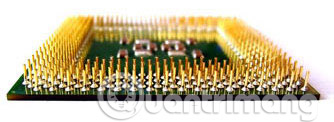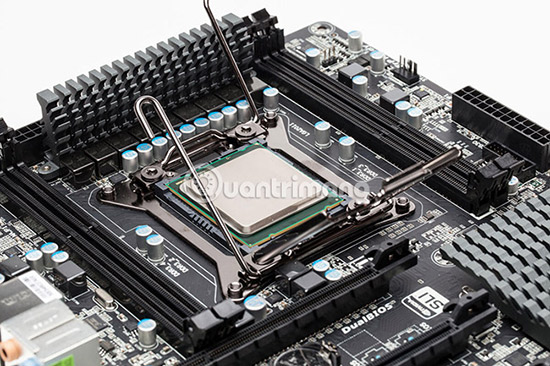What is the temperature of the processor in the computer?
The proper operating temperature of each processor depends on the manufacturer, the highest clock rate, the position of the sensor and the currently running program. However, this document will give you some general useful information about processor temperature under certain conditions.
Most processors in today's desktop computers are not allowed to exceed the temperature of 35 ° C and usually range from 21 ° C - 32 ° C. Below is a chart that lists many processor types and their average temperature. Remember, these figures are just to give users a general idea of processor temperature. If you think your computer is too hot, the reader may skip the bottom of this document that contains information about the safe temperature range for the processor.

How to know if the processor is too hot?
- How to check the computer's CPU temperature?

If the processor becomes too hot, the user will notice one or more of the following situations. Usually these problems will be encountered when running programs or especially when playing a high-end game.
- Computer runs much slower
- The computer restarts regularly
- Computer shut down suddenly
- Laptop fans shouted loudly and unusually hot and hot
Continued use of a computer with a processor that exceeds the allowed temperature will reduce its life.
Note: Depending on the computer hardware layout, the temperature sensor may not be placed in the optimal position. If so, the reported temperature may not be completely accurate. If the computer temperature is at its maximum or you are experiencing the above problems, try the following suggestions to reduce the temperature.
What to do to cool the processor?

The cooler the processor runs, the higher the performance. Therefore, if you are trying to overclock your processor or if it is too hot, users may need to consider some or all of the following recommendations.
1. Keep your computer clean - Over time, dirt and even hair can accumulate and prevent air from getting in or out of the body. Make sure the computer case part and ventilation are cleaned.
2. Improve your computer's environment - Make sure your computer is running in a good location. The computer should not be in an enclosed space such as a drawer or cabinet unless there is a ventilation element on the back of the drawer or cabinet. Computers should not be placed in a tight space, both sides of the computer and the back of the computer should be at least 5cm away from walls or other obstructions.
3. Check the radiator fan - Make sure all the cooling fans in the computer are working properly. Some motherboards and computers have displays that display the RPM of each main fan in the computer and whether they work properly. On the other hand, users also need to check each fan and look for any possible problems or listen to any unusual noises to determine if the fan is working properly.
4. Heat sinks - If the processor or fan has recently been replaced or repaired, you should clean them and apply additional heat sinks to make heat transfer from the processor easier.
5. Installing a fan - Consider installing a fan to the computer. Almost all computers will come with a heat sink and fan, as well as a case fan. However, most cases can install the second fan, making the computer more "cool". Computer enthusiasts can also create their own air ducts along with fans to help push out more hot air.
6. Use better fans - Many computers and processors will come with cheap fans to reduce overall costs. Installing a fan or high-end radiator can help the heat get out of the processor better and faster, making it always in a "cool" state.
7. Alternatives - More advanced users or users who are overclocking may also want to consider alternatives such as water cooling to keep the processor temperature not too high.
Hope you are succesful.
See more:
- 5 ways to cool down, cool, laptop radiator simple and effective
- 8 things to do when cleaning the computer
You should read it
- 8 ways to check Intel processor generation on Windows
- How to Upgrade Your Computer's Processor
- Instructions for undervolt reducing CPU temperature
- CPU: Speed is not all
- What is the CPU?
- How to change the Maximum processor frequency setting in Windows 10
- Steps to add/remove 'Maximum processor state' from Power Options in Windows
- AnTuTu announces the best processors 2020 on Android
May be interested
- 5 Simple and Effective Ways to Reduce CPU Temperature
 your computer is often hot and has a high temperature? let's explore the top 5 simple ways to reduce the increasingly hot cpu temperature to fix it.
your computer is often hot and has a high temperature? let's explore the top 5 simple ways to reduce the increasingly hot cpu temperature to fix it. - What is the ideal GPU temperature? How to check GPU temperature?
 as a result, gpus tend to reach higher temperatures than cpus in most workloads. but what is the safe gpu temperature range and how do you check your gpu temperature in real time?
as a result, gpus tend to reach higher temperatures than cpus in most workloads. but what is the safe gpu temperature range and how do you check your gpu temperature in real time? - How to check computer CPU temperature with software on Windows 10
 summary of the simplest and most accurate ways to check computer and laptop cpu temperature.
summary of the simplest and most accurate ways to check computer and laptop cpu temperature. - Top 5 Most Accurate Computer CPU Temperature Measurement Software 2024
 to know if your cpu is overheating, the following computer cpu temperature measuring software will help you know the most accurate cpu temperature.
to know if your cpu is overheating, the following computer cpu temperature measuring software will help you know the most accurate cpu temperature. - How to adjust the refrigerator temperature Samsung, Sharp, Panasonic, Toshiba, LG
 regulating refrigerator temperature is a very important job, affecting the quality of food with the ability to save electricity as well as the durability of the cabinet. here's how to adjust the refrigerator temperature to some common codes. let's check it out!
regulating refrigerator temperature is a very important job, affecting the quality of food with the ability to save electricity as well as the durability of the cabinet. here's how to adjust the refrigerator temperature to some common codes. let's check it out! - How to use SpeedFan to check CPU temperature, fan speed, computer
 speedfan tool monitors your cpu temperature, efficiency, and fan speed to help you cool down your computer.
speedfan tool monitors your cpu temperature, efficiency, and fan speed to help you cool down your computer. - Check computer temperature: CPU, VGA (video card), HDD (hard drive)
 check the computer temperature: cpu, vga (video card), hdd (hard drive) - use a lot of computers you want to know the temperature of the computer to find a way to fix when the machine is overheating to avoid performance status of the cpu reduces and damages critical parts of the computer.
check the computer temperature: cpu, vga (video card), hdd (hard drive) - use a lot of computers you want to know the temperature of the computer to find a way to fix when the machine is overheating to avoid performance status of the cpu reduces and damages critical parts of the computer. - Why natural computer off?
 if windows turns off in an unclear way and your computer shuts down, most of such cases are caused by overheating. the computer with the cpu temperature checker, then you will protect the internal components to avoid temperature malfunction.
if windows turns off in an unclear way and your computer shuts down, most of such cases are caused by overheating. the computer with the cpu temperature checker, then you will protect the internal components to avoid temperature malfunction. - How much is reasonable to regulate refrigerator temperature?
 the adjustment of the refrigerator temperature so that it is reasonable, not all families are interested and known, as this will affect the food quality as well as the operating capacity of the machine.
the adjustment of the refrigerator temperature so that it is reasonable, not all families are interested and known, as this will affect the food quality as well as the operating capacity of the machine. - How to Clean Thermal Paste
 anyone who works on a computer knows that the computer will buzz during use. thermal paste is used to conduct heat from the processor to a component called the 'heatsink'. here, the heatsink will push the heat out to maintain a moderate temperature for the processor. this glue will dry out and will need to be replaced periodically. in computer maintenance and repair, replacing new thermal paste is relatively easy. first, you need to practice safety when working to avoid causing damage to yourself and your computer. after that, just clean the old glue and apply new thermal paste.[1] x research source
anyone who works on a computer knows that the computer will buzz during use. thermal paste is used to conduct heat from the processor to a component called the 'heatsink'. here, the heatsink will push the heat out to maintain a moderate temperature for the processor. this glue will dry out and will need to be replaced periodically. in computer maintenance and repair, replacing new thermal paste is relatively easy. first, you need to practice safety when working to avoid causing damage to yourself and your computer. after that, just clean the old glue and apply new thermal paste.[1] x research source










 Restart Windows Explorer when the system is 'suspended'
Restart Windows Explorer when the system is 'suspended' How to reformat an external hard drive does not cause data loss
How to reformat an external hard drive does not cause data loss How to use Auslogics Disk Defrag to defragment your hard drive
How to use Auslogics Disk Defrag to defragment your hard drive How to update and reinstall Realtek HD Audio Manager
How to update and reinstall Realtek HD Audio Manager Summary of driver error codes on Windows and how to fix them (Part 1)
Summary of driver error codes on Windows and how to fix them (Part 1) 10 shortcuts that users often accidentally hit
10 shortcuts that users often accidentally hit